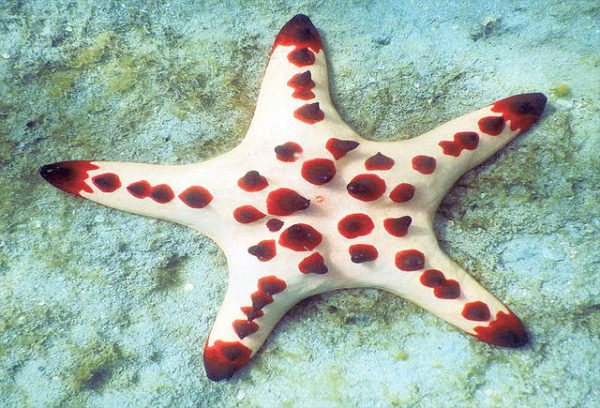Published in the Ocean Watch column, Honolulu Star-Advertiser © Susan Scott
June 2, 2018
I’ve just flown to Townsville, Australia, where we now keep our sailboat, Honu. We plan on sailing to nearby islands and, weather permitting, to the Great Barrier Reef. Because preparing the boat for voyaging takes a few days, as I listen to kookaburras laugh and cockatoos screech, I’ll share some recent reader emails.
University of Hawaii invertebrate zoology researcher Julie Bailey- Brock wrote that she liked my column on brittle stars and suggested I update readers on the current practice in invertebrate zoology field trips. Educators today emphasize that students return rocks to their original position and orientation, thus keeping top dwellers in the light and bottom dwellers hidden.
 This creature may be called a starfish,
This creature may be called a starfish,
a sea star or a Protoreaster. Take your pick.
©2018 Susan Scott
For learning about marine animals, there’s nothing like hands-on experience. But because the animals we’re admiring don’t have hands, it’s important we use ours to replace the creature’s rock homes as we found them.
Last week we piled the surf-scattered rocks tops up and released our two brittle stars in deep cracks.
Speaking of stars, an anonymous reader wondered why I use the term starfish. “I thought the usage of starfish was pretty much out of vogue. … I now use and read about sea stars. Wondering why your brittle stars column used the former terminology.”
Vogue is the right word, in my opinion. Some years ago, unknown (to me) marine scientists decided to change the names of starfish and jellyfish to sea stars and sea jellies, apparently because the creatures are not fish.
But I’ve never met anyone who thought those animals were fish, or anyone who thought sea horses were tiny horses or that sperm whales had their heads full of sperm. I’ve tried saying sea stars, and half the time people say, “You mean starfish?”
Yes. I mean starfish. And jellyfish, too.
With so many pressing issues in the world of marine conservation, changing common names seems like a wasted educational opportunity. I prefer to concentrate on how individuals can make a difference, such as by supporting the creation of marine sanctuaries, helping reduce marine pollution and protecting the reefs we love by keeping feet off coral and turning rocks back the right way.
Finally, reader Sarah writes that she came across my 2002 column about the mystery of flashing blue dots I saw at Hanauma Bay. I have never found the answer to what they are, nor has Sarah, who has also seen them in the Caribbean.
She writes, “I’m becoming convinced that perhaps it’s fairy mist sprinkled by mermaids to delight us drab mortals.”
I agree. And in a few days, hopefully, this drab mortal will be looking for some of that fairy dust on Australia’s Great Barrier Reef.
Thank you all for writing.